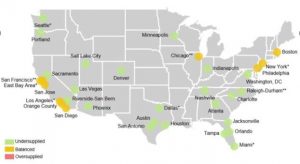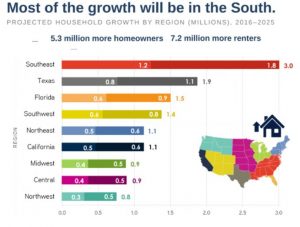On May 14th, the 2nd largest owner of single family homes in the U.S., American Homes 4 Rent, announced a partnership with Wall Street firm J.P. Morgan whereby they will be joining forces to build 2,500 new rental homes. American Homes 4 Rent, which currently owns approximately 53,000 single family homes, traditionally acquires existing homes, fixes them up and then turns them into rentals.
American Homes 4 Rent isn’t the 1st institutional single family rental company to look to the build for rent model. Invitation Homes, which owns an estimated 80,000 SFR’s in 17 markets has also done this. We will see more of it.
What’s driving the trend
- Lack of inventory
Contrary to the 2009 to 2017 time period when most of the institutional buyers did the bulk of their acquisitions, there simply is not enough supply of affordable homes that fit the single family rental business model. As per John Burns Real Estate Consulting, among the 33 significant housing markets in the U.S. 23 of them are considered under supplied. 10 of them are in balance and none of them are oversupplied. (See graphic below)

2. Desire to scale quickly
Institutional investors are motivated to get bigger and to do it rapidly. As per the graphic below, with an estimated 7.2 million new renter households expected to be formed between 2016 and 2025, the institutions simply do not want to wait for new inventory to trickle onto the market. The race is on capture all of these tenants and the institutional guys and gals are now of the mindset of “if you want something done, do it yourself”

3. The model has been validated at scale and there are tools to support it
In 2012, Warren Buffett, when appearing on CNBC, said “If I had a way of buying a couple hundred thousand single family homes….and managing them…I would load up on them”
Well, with motivation and modern technology, institutional investors have figured out how to manage SFR’s at scale and in the process have proven out their business model. They have validated it to the point where they can now attract capital from the JP Morgans of the world. Historically, within the housing sector, it was believed that only large multi-family developments could be managed at institutional level scale
Is there opportunity for you and I?
In some ways, my real estate investing journey parallels that of the institutional investors that were formed at the latter part of this century’s 1st decade. My wife and I did most of our acquisition between 2009 and 2015 and then hit a wall.
We focused on foreclosed homes built after 2000 in B class neighborhoods in cities where there was expected population growth and job growth. We targeted a minimum of $300/month in cash flow per unit when putting down between 5 and 20%. (Yes, there were investor loans that only required 5% down at the time) Given the trends in building and lending leading up to this point in time, there was reasonable supply of this product.
And then there wasn’t.
In 2015, our model broke down. The inventory was depleted, the lending programs with lower down payments were gone and prices had gone up to the point where the cash flow was much less attractive.
Despite our desire and effort to figure out a way to continue to scale, we could not make the numbers work. We went 4 years without making an acquisition until one of my property managers brought me an off market deal that made sense in 2019.
Modern tools & teams make it manageable
With online home search sites (Zillow, Redfin, Realtor.com etc..), enhanced property management software (Appfolio, Propertyware etc..), municipalities posting real estate information in online public records and a spreadsheet, it became fairly straightforward to understand what investing in a particular home would look like.
We were fortunate to find quality property managers in all markets to manage the investments and of the rental homes we own across 7 states, we have only ever seen or set foot in 1 of them. Without the now existing technology and communication tools, we would not have felt comfortable managing a portfolio of SFR’s. In fact, with these things and our teams in place, we spend very little time and effort on the portfolio.
The pivot
With strong belief in the acquire and hold model, yet very little inventory available that fit our criteria, we, not unlike the institutional investors, have adjusted our model to focus on new construction. At the end of March we closed on a couple of new build 4 unit town homes in Tennessee using equity from our existing portfolio. (See: How Houses Can Buy You Houses – The Power Of Equity & HELOCS)
The fact that our property manager, despite operating during a global pandemic, sourced renters for all 8 units within 60 days of closing helps to validate the predictions about renter household growth in the Southeast.
We, just like the institutional investors, know that the risks to the acquire and hold model are vacancy and maintenance. Another compelling driver for the build to rent model is that with new construction, both risks are diminished in the early years after acquisition. Newer things are much less likely to break and newer units are likely to not only attract quality tenants, but keep them as well.
What’s more, insurance costs for new construction tend to be measurably less which helps to improve cash flow.
Summary
I have mixed emotions about institutional players in the SFR market. On the one hand they can be viewed as competition. My model broke down in 2015 because by that time the big guys had scooped up a lot of the inventory. On the other hand by doing this they also accelerated home price appreciation. There is also a lot of learning that can be gleaned by following what the institutional investors do. They are constantly looking at macro economic trends and what they mean for the housing sector.
It is clear that institutional investors believe the build to rent model will be a winner in certain markets across the country. In addition to lower maintenance, vacancy and insurance costs, the increased predictability (no rehab estimating, no rehab execution) of acquiring new construction in markets where rental demand is high makes the model very compelling for non-institutional investors as well.













